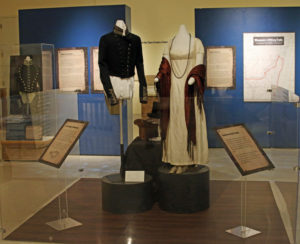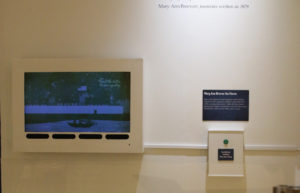by Louise Pfotenhauer, Collections Manager, Neville Public Museum

Mary Ann Brevort and a handful of military companions set out for what was to be a short trip home across the Fox River after attending a dance at military Fort Howard. Instead, the group spent hours braving wind, rain, and cold as you can see in this digital element created for the 2016 Life and Death at Fort Howard exhibit at the Neville Public Museum.
The piece, a compilation of the reading of Mary Ann’s written recollection of the event along with original animation, is just one example of the many digital interactives created for exhibits each year.
Take a look at an example of our digital interactives: “Life and Death at Fort Howard” (opens in a new tab).

Exhibit digital interactives come in a variety of shapes and sizes, formats and resolutions, which is something UW-Milwaukee SOIS student Stephanie Surach and I quickly learned as we gathered information for this summer’s Curating Community Digital Collections (CCDC) project.
The Neville has been creating digital content for exhibits since 2005 when we installed the Hometown Advantage Theater which consisted of 8 original videos telling the story of the Green Bay Packer’s relationship to the community. The commissioned videos are a compilation of born-digital original interviews, as well as digitized historic film footage and still images from the Neville’s collection.
That equals a medium level complexity interactive according to the scale Stephanie created to aid in the inventorying of the interactives.
- Medium complexity: The interactive can contain one or more types of digital media that have been created either in-house or commissioned and contains a composite of the different types of media. Examples include an edited video that contains digitized or born-digital moving images, still images, audio tracks, and exhibit animations that include an audio track.
- Low complexity: The interactive contains only one type of digital media mediated by either an analog or digital interface. Examples include a touch-screen slide show of digital images or a push-button that plays stand-alone audio or video.
- High complexity: The interactive contains two or more types of digital media (i.e. still images, audio, video) that are interconnected and in which the user has a choice(s) beyond “play” when using the interactive. Examples can include gamified or decision-tree/choose your own adventure digital elements.

Regardless of how we classify the interactives, our future digital preservation policy will stress applying the best practices we discussed during the May CCDC workshop, such as consistent file naming, 3-2-1 storage, and integrity checks.
It’s been a great summer!
Visit Curating Community Digital Collections for more information about this project. This project is made possible by the Institute of Museum and Library Services, #RE-85-17-0127-17.



You must be logged in to post a comment.